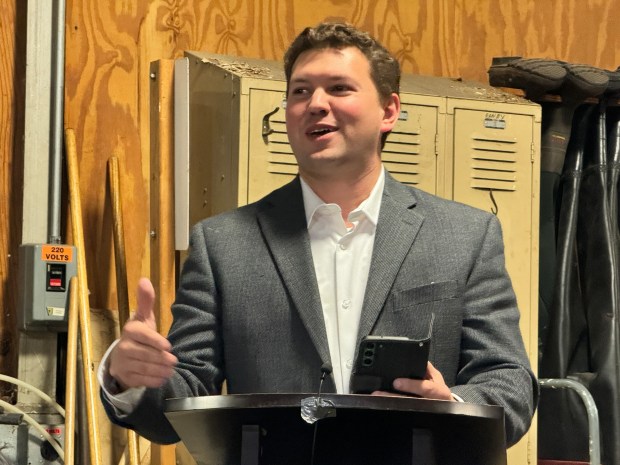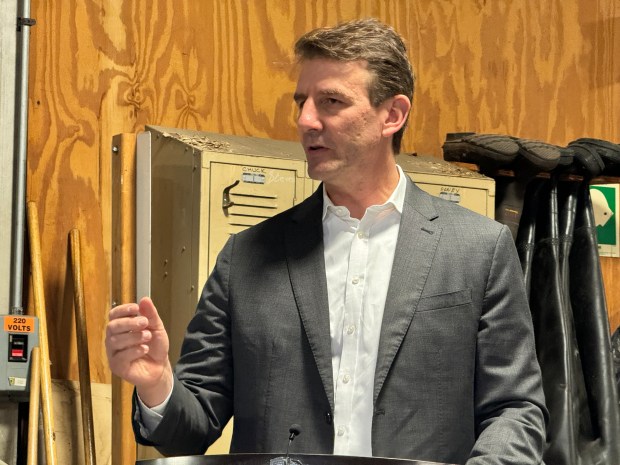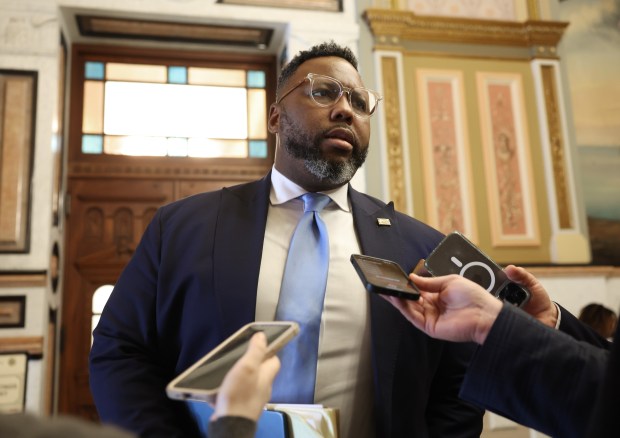Work begins next week on an $8 million modernization project at Portage’s wastewater treatment plant following Tuesday’s ceremonial groundbreaking.
The project includes replacing four 43-year-old clarifiers and adding a solar field to reduce the plant’s NIPSCO bills by 30%.
The plant could become a model for other communities, Councilman Collin Czilli, D-5, said.
“Investing in green solar energy is an amazing way to save money and make our facility better in the long run and to cut down on the amount of money we are spending on our NIPSCO bills to operate our facility,” he said.
“If we can save 30% on our NIPSCO bill here at the facility, that’s more money we can put in the staffing, that’s more money we can put into improvements in the future, and that needs to be a model for communities across the country,” Czilli said.
Initially, the idea was to replace the clarifiers to make sure the plant could continue operating. The federal infrastructure bill eased the way for federal funding for the clarifiers. The Inflation Reduction Act allowed Portage to add the solar field to the project last year, said former Mayor Sue Lynch, who made the wastewater treatment plant modernization a priority during her administration.
“I don’t think we can state enough how important this facility is,” Czilli said. “If this facility were to fail, 90% of the city would not be able to flush their toilets.”
Without the federal funding for the lion’s share of the project, the project would have been a no-go, Czilli said. The city would have had to raise sewer rates, and the council didn’t want to do that.
“As a member of Congress, my job is just to be able to pass legislation that is beneficial to the cities and towns in Northwest Indiana,” said U.S. Rep. Frank Mrvan, D-Highland.
The infrastructure bill provided money for the state revolving fund for projects like this one, he noted.
Mayor Austin Bonta said he was in Washington, D.C., two weeks ago with a delegation of mayors from Great Lakes states and provinces to advocate for federal funding for local projects.
“There was one part where all these mayors from cities like Sheboygan, cities like Muskegon, great cities like Flint, Michigan, were all talking about how difficult it is to work to get funding through SRF and want Congress to help make it easier for them,” he said.
“I was trying to be very quiet,” Bonta said, when he realized how much Indiana’s congressional delegation does to work with cities like Portage to help them get federal funds through the state revolving fund program.

“All I can say is just amazing teamwork to everybody,” Bonta said, including his predecessor and her administration.
Mrvan thanked 21-year treatment plant employee John McClure for telling him in just 30 seconds how important the project is to the city.
“Without missing a beat, he said it’s very important because it’s cleaner water; it makes sure that we increase our capacity, which allows the tools for greater economic development to bring in more businesses; assures clear water and quality of life,” as well as saving energy.
The project is years in the making. Czilli said talks began with Lynch and plant Superintendent Tracie Marshall about three or four years ago.
Lynch was adamant about replacing the clarifiers. She was glad to see the solar field added to the project, too. Marshall’s predecessor at the plant had floated the idea of windmills there to produce some of the electricity for the plant.
The solar field can be expanded, Lynch said.
Project manager Andrew Robarge, of Commonwealth Engineers, said the clarifier replacement will be carefully staged to make sure the plant continues functioning properly. Each clarifier will be replaced in turns to make sure everything works properly before moving onto the next one.
The replacement project is just in time. “The clarifiers are 43 years old, and they had never been replaced,” Lynch said. “That’s ancient for them.”
“It’s to the point where they’re saying if it breaks, we don’t know if we can fix it or not,” Robarge said. The clarifiers were installed in 1970 and last rehabbed in 1983.
Marshall said she hopes construction will be finished in January.
With this project underway, the city is moving rapidly toward its next major sewer infrastructure project.
The Sanitary Board was set to hold a special meeting Wednesday to approve seeking state revolving fund money for a new ultraviolet radiation system for the plant, bringing it up to modern standards, and $6 million to reline pipes, as well as adding a lift station and sewer lines on the city’s north side.
“It’s good to know that the water goes where it’s intended to go” before developing 80 acres the city owns on the north side, Bonta said.
Extending Burns Parkway will be key to opening that area for economic development, he said.
World’s Finest Chocolate is in talks with the city for a major development in the area, Lynch noted. The company signed a letter of intent late last year.
Doug Ross is a freelance reporter for the Post-Tribune.





